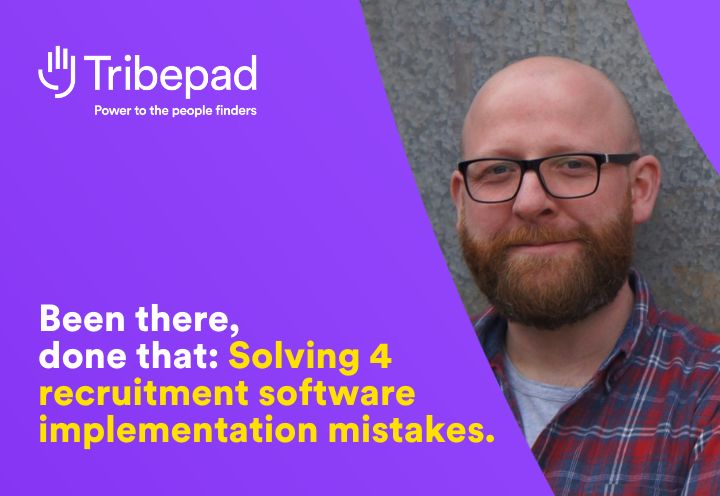If you’re a one-person recruitment function handling in-house recruitment for an SME, what talent tech do you need to ensure you can support – not stall – growth? We spoke to Hung Lee and three wonderful small business recruiters to understand when SMEs should move from spreadsheets to software.
In-house recruitment in SMEs is typically performed by one person. If that. It’s not uncommon for that one person to also have broader HR or office management responsibility.
This solo recruiter is often responsible for the whole shebang:
- Setting talent acquisition strategy
- Building an internal hiring process
- Creating, posting, and closing job adverts
- Managing attraction and search
- Screening and arranging interviews
- Setting and upholding recruitment standards
- Reporting and providing insights to senior leaders
- Issuing offers and contracts
- Checking references and compliance docs
- Ordering equipment, setting start-dates and so on
- Organising and conducting training
- Communicating with candidates and new hires
It’s an enormous workload. One that, understandably, can be totally overwhelming. Especially in growing businesses where recruitment demand is steadily outstripping the resources (time; tech; tools) you have to play with.
But how do you know when’s the right time to invest into recruitment tech? When does it become untenable not to have an ATS?
In the second session of our four-part webinar series with Recruiting Brainfood’s Hung Lee, we asked three fabulous panellists who are navigating these challenges:
- Alan Walker, Co-Founder, Udder
- Tracy Chau, Talent Partner, Simmons Bars
- Katie Cooper, Group Recruitment Specialist, Lucion Services
When do small businesses need recruitment software?
We’ve heard before from Tony Walton – formerly Head of In-house Recruitment for Compass Group and now Managing Director of Talent Genius – that not implementing recruitment tech soon enough is a major recruitment challenge for SMEs.
But there’s no single answer to when you should implement software. Of course, the ideal answer is immediately – but that’s often not realistic.
Tracy joined Simmons Bars when they had around 300 employees and everything was still being handled manually, for instance. But getting an ATS was the first thing she did – and the company has now met their hiring targets for the first time ever.
Alan reckons most SMEs he sees invest into an ATS when they’re hiring around 20 to 40 people a year but it’s not an exact science. He points out that getting an ATS is less about company size than about hiring volume – and within that, candidate volume:
“If you’re hiring four or five roles a month but you’re only dealing with two or three candidates a role, you can probably still manage without an ATS. But if you’re handling three roles a month but you’re getting 300 applicants for every single role, it’s a different story.”
A big issue here is brand and protecting the candidate experience. How many candidates can a single recruiter process without becoming a bottleneck?
Brand is crucial when you’re growing a business, and candidate’s experiences impact consumer brand. Ultimately, poor recruitment practice makes it harder to grow your customer base and revenue, as well as headcount.
How to tell when spreadsheets are holding you back
One of the major topics in the session was the triggers that tell you — and your senior leaders, who are signing off on the investment – that it’s time to consider an ATS.
Again, there’s no single answer. But there are some common triggers that many small and growing businesses experience, where recruitment software starts to make good sense.
1 – Spiralling spend
Spreadsheets make understanding costs extremely difficult, let alone controlling them. For example – what’s your best source of hire? Where should you invest more versus less? Do you have automatic spending caps to protect you from overpaying boards?
If you’re noticing you’re spending more on advertising and agencies but aren’t reaping enough reward, an ATS could make a lot of sense. Recruitment software typically gives you much better visibility and control over your end-to-end recruitment process, so you can become more cost-efficient.
2 – Struggling with reporting
For Katie, the main trigger for upgrading their ATS was demand for – and difficulty delivering – reports to the board. She was spending hours lost in spreadsheets because even simple reports, like how many people they’d made offers to, took enormous retrospective manual effort.
Upgrading meant getting much better recruitment reporting at the click of a button, with an intuitive, easy-to-use dashboard.
3 – High dropouts
Solo recruiters have enough on their plate with recruitment-as-usual. Let alone if you also having to recruit twice (or more) because of dropouts.
Dropouts typically happen either when there’s a poor fit, or because great candidates get frustrated with a slow, difficult process and leave for another role.
In both cases, this can quickly turn into a vicious cycle. You’re under more pressure, with less time. The hiring experience takes a hit, and you make more hurried hiring decisions – both leading to more dropouts.
If that’s a cycle that your organisation is experiencing or you’re in a high turnover industry, that could be a good trigger for getting an ATS. Good talent tech makes dropouts less likely, by improving the candidate experience, assessments, onboarding, and quality of hire.
4 – Ambitious growth plans
Some smaller businesses can get away without an ATS forever. If you’re only hiring a handful of people and you don’t foresee that changing in the next couple of years, an ATS might be overegging the pudding.
But what if you’re only hiring a handful of people right now, but you have big growth plans for the future? If we’re talking two-year horizon rather than five-years plus, getting the systems in place now to support growth often makes sense.
If you wait to invest into recruitment software until you’re already struggling, you’re working against yourself.
So… do you need an ATS?
There’s no hard and fast answer. Whether an ATS makes sense for you right now depends on your business challenges – both today and how you expect those to change in the future.
Once you understand that, the answer is usually obvious (either way).
If you do discover you have a clear problem, that’s a great start to approaching the market. There are thousands of recruitment software providers: knowing precisely which problem you need to solve helps you choose the right vendor for you.
Tribepad Gro is ready built, ready-to-go recruitment software for growing teams. Take your recruitment to the next level. Get your free recruitment diagnostic session with Tribepad consultants Dan and Hayley to learn what could be stalling your growth.




